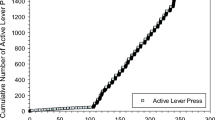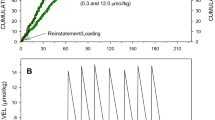Abstract
Drug discrimination procedures typically provide for multiple choice opportunities per training session. This practice allows non-drug cues (presence or absence of reinforcement) to mediate choice behavior during that portion of the session following the initial choice. In this experiment, rats were trained to discriminate 1.0 mg/kg cyclazocine from saline using a novel procedure that employed a single-choice trial per training session. Drug discrimination acquisition and generalization were compared to those of rats given discrimination training with 30 choice trials per session. The one-trial procedure yielded stable and reliable acquisition but more slowly than did the multiple trials procedure. The one-trial procedure produced longer first trial choice latencies and enhanced the tendency for subjects to respond on both choice levers during the first trial. The cyclazocine generalization functions were comparable, but the one-trial subjects more often responded on both choice levers, particularly when administered intermediate test doses of cyclazocine. Control of choice behavior by the reinforcer cue was evaluated on a mid-session cue reversal test. Multiple-trial subjects persisted in responding on the saline level following a midsession injection of cyclazocine, whereas one-trial subjects shifted to the cyclazocine-appropriate lever.
Similar content being viewed by others
References
Appel JB, White FJ, Kuhn DM (1978) The use of drugs as discriminative stimuli in behavioral pharmacodynamics. In: Colpaert FC, Rosecrans JA (eds) Stimulus properties of drugs: ten years of progress. Elsevier/North Holland Biomedical, Amsterdam, pp 7–29
Barry H, Krimmer EC (1978) Pharmacology of discriminative drug stimuli. In: Ho BT, Richards DW III, Chute DL (eds) Drug discrimination and state dependent learning. Academic, New York, pp 3–4
Colpaert FC (1977) Drug-produced cues and states: some theoretical and methodological inferences. In: Lal H (ed) Discriminative stimulus properties of drugs. Plenum, New York, pp 5–21
Colpaert FC (1978) Some properties of drugs as physiological signals: The FR procedure and signal detection theory. In: Colpaert FC, Rosecrans JA (eds) Stimulus properties of drugs: ten years of progress. Elsevier/North Holland Biomedical, Amsterdam, pp 217–242
Colpaert FC, Rosecrans JA (1978) Stimulus properties of drugs: ten years of progress. Elsevier/North-Holland, Biomedical
Colpaert FC, Slangen JL (1982) Drug discrimination: applications in CNS pharmacology. Elsevier Biomedical
Colpaert FC, Niemegeers CJE, Janssen PAJ (1975) Investigations of drug-produced and subjectively experienced stimuli. 1. The fentanyl cue, a tool to investigate subjectively experienced drug actions. Life Sci 16:705–716
Colpaert FC, Niemegeers CJE, Janssen PAJ (1977) Differential haloperidol effect on two indices of fentanyl-saline discrimination. Psychopharmacology 53:169–173
Goudie AJ (1977) Discriminative stimulus properties of fenfluramine in an operant task: An analysis of its cue function. Psychopharmacology 53:97–102
Herling S, Woods JH (1981) Mini-Symposium: discriminative stimulus effects of narcotics: Evidence for multiple receptor-mediated actions. Life Sci 28:1571–1584
Hirschorn ID (1977) Pentazocine, cyclazocine, and nalorphine as discriminative stimuli. Psychopharmacology 54:289–294
Holtzman SG (1980) Phencyclidine-like discriminative effects of opioids in rats. J Pharmacol Exp Ther 214:614–619
Jarbe TUC (1978) Discriminative effects of morphine in the pigeon. Pharmacol Biochem Behav 9:411–416
Jenkins HM (1965) Measurement of stimulus control during discriminative operant conditioning. Psychol Bull 64:365–376
Kelleher RT (1966) Chaining and conditioned reinforcement. In: Honig WK (ed) Operant behavior: areas of research and application. Appleton-Century-Crofts, New York, pp 160–212
Mackintosh NJ (1974) The psychology of animal learning. Academic, London, pp 580–582
McMillan DE, Cole-Fullenwider DA, Hardwick WC, Wenger GR (1982) Phencyclidine discrimination in the pigeon using color-tracking under second-order schedules. J Exp Anal Behav 37:143–147
Overton DA (1982) Multiple drug training as a method for increasing the specificity of the drug discrimination procedure. J Pharmacol Exp Ther 221:166–172
Schuster CR (1976) Behavioral methods for the study of drug interactions. Ann NY Acad Sci 281:64–73
Teal JJ, Holtzman SG (1980) Discriminative stimulus effects of cyclazocine in the rat. J Pharmacol Exp Ther 212:368–376
Tomie A, Loukas R, Stafford I, Peoples L, Wagner G (1985) Drug discrimination training with a single choice trial per session. Psychopharmacology 86:217–222
Author information
Authors and Affiliations
Rights and permissions
About this article
Cite this article
Tomie, A., Peoples, L. & Wagner, G.C. Effects of single or multiple choice trials per session on drug discrimination performance. Psychopharmacology 92, 529–535 (1987). https://doi.org/10.1007/BF00176490
Received:
Revised:
Issue Date:
DOI: https://doi.org/10.1007/BF00176490




